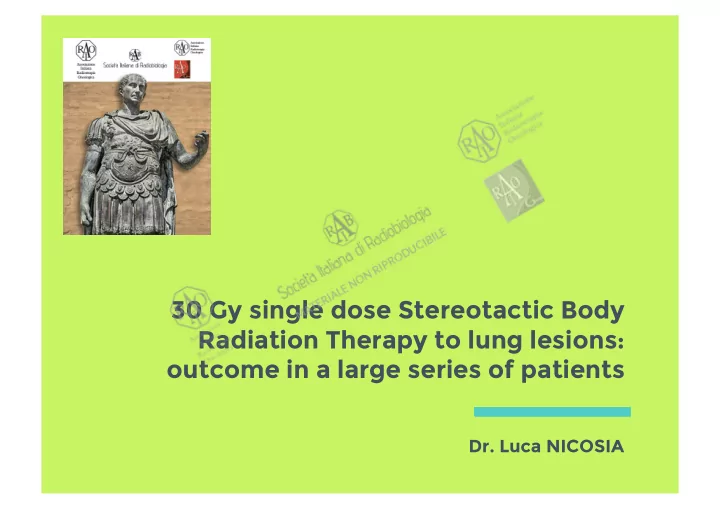

30 Gy single dose Stereotactic Body Radiation Therapy to lung lesions: outcome in a large series of patients Dr. Luca NICOSIA
Background Lung ¡is ¡one ¡of ¡the ¡primary ¡site ¡of ¡metastases ¡from ¡solid ¡tumor ¡ Local ¡treatment ¡include ¡surgery ¡and ¡radiotherapy ¡ SBRT ¡is ¡a ¡useful ¡tool ¡to ¡treat ¡oligometasta9c* ¡disease ¡ ADVANTAGES ¡ DISADVANTAGES ¡ Op9mal ¡dose ¡schedule ¡for ¡SBRT ¡to ¡ Op9mal ¡local ¡control ¡ the ¡lung ¡is ¡s9ll ¡under ¡inves9ga9on ¡ Low ¡toxicity ¡ Dangerous ¡localiza9ons ¡ Good ¡compliance ¡ Low ¡costs ¡ * ¡Hellman ¡S, ¡Weichselbaum ¡RR. ¡Oligometastases. ¡J ¡Clin ¡Oncol ¡1995;13:8–10 ¡
103 ¡lung ¡lesions ¡in ¡66 ¡pa9ents ¡ ‘’ 15 ¡months ¡FUP ¡ Dose LC 1 year 23Gy/1fr 79.4% 49 lesions 30Gy/1fr 94.7% 54 lesions Dose-‑response ¡ rela9onship ¡ Although ¡difference ¡was ¡not ¡sta9s9cally ¡significant.. ¡
Retrospective analysis: Large series of oligometastatic to the lung cancer or primary lung cancer treated with single dose 30 Gy SBRT Response ¡ LPFS ¡ Toxicity ¡ Survival ¡(OS, ¡ DFS, ¡ ¡ MFS, ¡CSS) ¡
Pa#ent’s ¡ charateris#cs ¡(n=160) ¡ Materials and methods Mean ¡Age ¡ 70 ¡(24-‑90) ¡ Sex ¡ Male ¡ 99 ¡(62) ¡ 201 ¡lung ¡lesions ¡in ¡160 ¡pa9ents ¡ Inclusion ¡criteria: ¡ Female ¡ 61 ¡(38) ¡ Loca9on ¡of ¡Primary ¡Cancer ¡ OLIGOMETASTATIC ¡ Lung ¡ 82 ¡(51.5) ¡ Controlled ¡primary ¡tumor ¡ Colon-‑rectum ¡ 41 ¡(25.5) ¡ Breast ¡ 8 ¡(5) ¡ ≤4 ¡ synchronous ¡ or ¡ metachronous ¡ lung ¡ metastases ¡at ¡the ¡9me ¡of ¡treatment; ¡ ¡ Others ¡ 29 ¡(18) ¡ Primary/metastasis ¡(n=201) ¡ Primary ¡ 35 ¡(17.4) ¡ EARLY-‑STAGE ¡NSCLC ¡ Metastasis ¡ 166 ¡(82.6) ¡ Primary ¡lung ¡tumor ¡stage ¡I ¡or ¡II, ¡not ¡candidate ¡ to ¡surgery; ¡ ¡ Site ¡ Peripheral ¡ 149 ¡(74) ¡ No ¡other ¡ac9ve ¡sites ¡of ¡distant ¡metastasis ¡ Central ¡ 52 ¡(26) ¡
Constraints ¡ Esophagus ¡ <15.4Gy ¡ Mean ¡size ¡ V20 ¡<10% ¡ Total ¡lung ¡volume ¡ 15.7 ¡mm ¡ 2-‑50 ¡mm ¡ V10 ¡<20% ¡ Mean ¡PTV ¡volume ¡ MLD ¡ <15Gy ¡ 8.7 ¡cc ¡ ¡ (0.95 ¡– ¡65.1) ¡ Spinal ¡chord ¡ <14Gy ¡ N° ¡of ¡lung ¡metastases ¡ Hearth/Pericardium ¡ <22Gy ¡ 1 ¡ 128 ¡(80) ¡ Great ¡vessels ¡ <37Gy ¡ 2 ¡ 27 ¡(17) ¡ Trachea ¡and ¡ <2.2Gy ¡ proximal ¡bronchi ¡ 3-‑5 ¡ 5 ¡(3) ¡ Skin ¡ <26Gy ¡ Brachial ¡plexus ¡ <17.5Gy ¡ Rib ¡ <30Gy ¡ CHT ¡before ¡SBRT ¡ CHT ¡aUer ¡SBRT ¡ Yes ¡ 114(71) ¡ Yes ¡ 104 ¡(65) ¡ No ¡ 46 ¡(29) ¡ No ¡ 56 ¡(35) ¡
Results Response and survival
0.5% ¡ 11.5% ¡ 21.4% ¡ 66.6% ¡ Overall ¡response ¡rate ¡was ¡ 99.5% ¡(200/201 ¡lesions) ¡
Median ¡OS ¡ Early-‑stage: ¡42 ¡mo ¡ Median ¡OS: ¡40 ¡mo ¡ Oligomts: ¡39 ¡mo ¡ ¡p ¡n.s. ¡ ¡p ¡n.s. ¡ Median ¡CSS: ¡ Median ¡CSS ¡ ¡ (total): ¡48 ¡mo ¡ Early ¡stage: ¡n.r. ¡ 1 ¡year: ¡84.7% ¡ Oligomts: ¡50 ¡mo ¡ 2 ¡years: ¡63.9% ¡ 5 ¡years: ¡38% ¡
LPFS ¡ ¡ Median ¡LPFS: ¡n.r. ¡ Early ¡stage/Oligomts ¡ p ¡n.s. ¡ 1 ¡year: ¡86.9% ¡ 2 ¡years: ¡77.5% ¡ 5 ¡years: ¡75.2% ¡
LPFS – response tailored Median ¡LPFS ¡ RC: ¡nr ¡ ¡p ¡0.000 ¡ GR: ¡14 ¡mo ¡ PR: ¡13 ¡mo ¡ SD: ¡15 ¡mo ¡ PR SD CR (median 13 (median 15 (median N.R.) mo) mo) 1 year 100% 61.6% 57.1% 2 years 98.2% 46.2% 50% 5 years 87.2% 46.2%
Why RC is so important?
Oligometastic disease hypotesis Local RC OS...? control
OS - response tailored ¡p ¡0.000 ¡ OS CR PR SD (median mo) (median mo) (median mo) 1 year 90.8% 64.1% 81.3% 2 years 76.5% 37.3% 39.5% 5 years 50.6% 17.1% 0%
LPFS- volume tailored Vol < 20 Vol > 20 cc cc 1 year 88.9% 77.9% 2 years 82.3% 57.1% P ¡0.005 ¡ 5 years 82.3% 47.6% A ¡volume ¡<20 ¡cc ¡is ¡ associated ¡with ¡LPFS ¡
OS – volume tailored P ¡0.018 ¡ The ¡same ¡pa9ents ¡ with ¡CR!! ¡ OS Vol < 20 cc Vol > 20 cc 1 year 85.9% 80% 2 years 67.5% 51.6% 5 years 44.3% 20.8%
Toxicit y Toxicity
G1-‑2 ¡Acute ¡toxicity ¡ ≥G3 ¡toxicity ¡ Others ¡ 1 ¡Toxic ¡death ¡ 43 ¡(21.3%) ¡cases ¡ 10 ¡(4.9%) ¡G≥3 ¡ (pneumoni9s) ¡ ¡ pneumoni9s ¡ pts ¡lost ¡on ¡ ¡ G1-‑2 ¡Late ¡toxicity ¡ FUP ¡aker ¡SBRT ¡ 12 ¡(5.9%) ¡cases ¡G≥3 ¡ 2 ¡cases ¡of ¡rib ¡ 80 ¡(39.8%) ¡lesions ¡ fibrosis ¡ fracture. ¡ These ¡ (asymptoma9c ¡ pa9ents ¡are ¡actually ¡ fibrosis) ¡ alive ¡aker ¡38 ¡and ¡71 ¡ from ¡SBRT ¡
Conclusions Conclusions
Take home message - 1 Efficacy Patients selection Toxicity 30 Gy can achieve Number of lesions and Well tolerated high rates of LC. dimensions, time to Early diagnosis and Longer survival in oligometastatization treatment of acute some oligometastatic toxicity! patients Low costs Easy interface with Care to peripheral One-day treatment systemic therapies lesions Execially when ribs are But best sequence it has near treatment field not been investigated
Take home message - 2 Unmet needs Randomized trial to assess the real efficacy of SBRT in the oligometastatic disease Identify the best sequence SBRT-systemic treatments, in order to maximize efficay and survival
Thanks! Any questions?
Recommend
More recommend